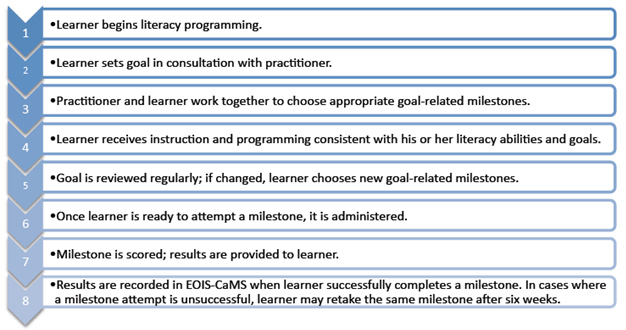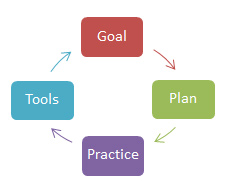 Ongoing Assessment
Ongoing Assessment
“What you See: Ongoing Assessment in the ESL/Literacy Classroom”
Ongoing assessment, as its name implies, takes place over the time the learner is in LBS training. According to the OALCF Foundations of Assessment, ongoing assessments are used to:
- monitor learner progress
- identify ways to help learners develop the abilities to achieve their goals
- identify any barriers to achieving their goals
The assessment should be done with the learner, not to the learner, so it allows both the instructor and the learner to examine:
- progress within the literacy learning plan
- what changes need to be made
- how well the learner plan reflects the current situation
Ongoing assessment often involves both formal and informal tools. Informal assessment can include something as simple as asking, “How’s it going?” or an impromptu review of a learner’s work. Formal assessment includes tests and milestones.
Whatever tools you use, you will need a way to track and document learners’ progress. This can include checklists of mastered skills, anecdotal documentation of observed progress, and self-assessments completed by the learner. This approach will help you and the learners know they have made progress and have concrete evidence to prove it.
A number of programs have designed ways to track the learners’ progress. We have included an example from ALSO (Alternative Learning Styles and Outlooks) in the Sample Forms section of this module. Literacy Council York-Simcoe has taken this a step further and created sheets for all five goal paths with example tasks for each competency. We have included their Further Education Tracker in the Sample Forms section.
Milestones
Milestones are goal-related assessment activities that are linked to the five goal paths by using tasks that utilize documents, texts, situations and interactions drawn from employment, further education, further training and everyday life. Each milestone is directly related to one competency, task group or level within the Curriculum Framework. Through successful completion of milestones, learners demonstrate their abilities to use their literacy skills to carry out goal-related tasks.
In the MTCU Requirements section earlier in this module, we discussed the need to keep milestones secure to ensure their integrity and to use them as instructed for consistency across the LBS field. The diagram below, from the OALCF Milestones User Guide shows how milestones are used within OALCF programming. Note: only authorized individuals may access the OALCF Milestone and Culminating Task Repository to download the User Guides, Indexes and the actual milestones and culminating tasks. If you do not have access yourself, please get a copy of the guides and indexes from your program’s authorized representative or have your EOIS CaMS Service Provider Registration Authority (SPRA) apply for your access through e-channel@contactnorth.ca.

Successfully completing a selected Milestone does not necessarily mean that learners can do other tasks at the same level or task group or that they are ready for transition. Although Milestones are an indicator of learner progress, they are not intended to stand alone. They should complement other assessment methods used to monitor learner progress. Gathering information from a variety of assessment methods will develop a more accurate understanding of the learners’ progress.
Demonstrating Learning Using Integrated Tasks
Integrated Tasks can be used to demonstrate a learner’s ability to apply multiple skills to complete complex, authentic tasks. Integrated Tasks are multi-layered, linking a number of competencies, task groups and even different levels. These tasks should resemble, as closely as possible, a real-life application of skills as they relate to the learner’s goals and goal path.
Learning activities and Integrated Tasks share many of the same features. For example:
- instructions to learners
- questions to be answered
- tasks to be accomplished
- methods to determine attainment of skills
Learning activities may even use authentic text or integrate more than one skill as they prepare learners for increasingly complex tasks. However, where learning activities are used to develop and support learning, Integrated Tasks are used to assess learning and show that the learner can apply skills to a real-life situation.
For examples of Integrated Tasks for each of the goal paths and more information about Integrated Tasks, see MTCU’s Integrated Tasks by Goal Path document. An excellent source of other sample tasks, many of which are integrated, is the QUILL Network’s Task-based Activities for LBS site.
Portfolios
Portfolios provide a way of gathering and organizing examples of learners’ work to show progress. They are not simply a binder or a box full of everything the learner has done. Rather, they are a carefully chosen selection of examples of the skills the learner has mastered over time and the tasks that the learner has performed. This includes samples of actual work the learner has completed along with assessments and any other relevant material.
Usually the learner and the tutor or instructor work together to choose what will be included in the portfolio. Discussing and selecting work for the portfolios provides a way to involve learners in self-evaluation and reflection.
Self-Assessment
Students can become better learners and improve their skills when they deliberately reflect on what they are learning, how they are learning it and what else they need to learn. By regularly stepping back from learning activities to think about their learning strategies and progress, learners become more self-reliant and motivated. It is, therefore, worth encouraging active participation in the assessment process by allowing learners to identify and document their own progress, skills, task performance, practice and changes.
Learner self-assessment is built on four key elements: 
- Goal setting
- Creating a plan
- Guided practice with self-assessment
- Assessment tools (journaling, KWL/KWHL, portfolios, mind mapping, etc.)
Pages: 1 2




